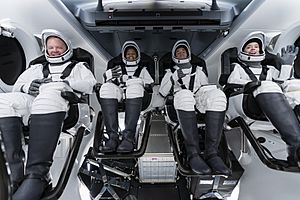Space tourism facts for kids
Space tourism is when people travel to space just for fun! There are different kinds of space tourism, like going into orbit around Earth, taking short trips just to the edge of space, or even dreaming about trips to the Moon. People want to go to space to see Earth from above, feel like they're floating, experience super-fast speeds, and do something truly amazing. Some even want to help with science while they're up there!
Space tourism officially began in April 2001. An American businessman named Dennis Tito was the very first space tourist. He flew aboard a Russian Soyuz spacecraft to the International Space Station (ISS). From 2001 to 2009, seven space tourists made eight trips to the ISS using Russian Soyuz spacecraft. These trips were arranged by an American company called Space Adventures with help from Russia's space agencies.
In September 2006, Anousheh Ansari became the first female space tourist. These early trips cost around $20–25 million each! Some space tourists even did small research projects while in space. By 2007, many thought space tourism would become a big business.
Before going to space, tourists need to be very fit. They train for strong forces (g-forces) in a special machine called a centrifuge. They also learn about weightlessness by flying in a jet plane that does special up-and-down movements. They might even practice how to use and fix parts of the spaceship using simulators.
Russia stopped orbital space tourism in 2010 because more astronauts were needed on the ISS. The seats that used to be sold to tourists were then used for crew members. Orbital tourist flights started again in 2021 with the launch of Soyuz MS-20.
On June 7, 2019, NASA announced that private citizens could start visiting the ISS from 2020. They would use spacecraft like SpaceX's Crew Dragon and Boeing Starliner. The cost was planned to be about $35,000 per day for an astronaut, plus an estimated $50 million for the ride there and back.
Companies like Blue Origin and Virgin Galactic are also working on vehicles for shorter trips to the edge of space. In 2018, SpaceX shared plans to send space tourists, including Yusaku Maezawa, on a trip around the Moon using their Starship rocket.
In the future, space tourism might involve space elevators, fancy space hotels, or even vacations in space colonies on the Moon or Mars!
Contents
Early Space Travelers
Before space tourism became a thing, some people who weren't professional astronauts got to fly into space. The Soviet Union had a program called Interkosmos. It allowed people from other countries, like Czechoslovakia and India, to become cosmonauts and fly on shorter missions.
The US Space Shuttle program also had "payload specialist" roles. These were for people from companies or universities who managed special equipment on a mission. They didn't get the same training as NASA astronauts. For example, Ulf Merbold and Byron Lichtenberg were the first payload specialists to fly on the Space Shuttle in 1983. In 1984, Charles D. Walker became the first non-government person to fly, with his company paying for his trip.
In the 1980s, NASA started a "Space Flight Participant" program for regular citizens. Christa McAuliffe, a teacher, was chosen to be the first "Teacher in Space" in 1985. Sadly, she died in the Challenger accident in 1986, and these programs were stopped.
At first, NASA leaders didn't like the idea of space tourism. But after the Soviet Union broke up, Russia's space industry needed money. So, they started allowing paying guests. In 1990, a Japanese reporter named Toyohiro Akiyama flew to the Mir space station. He gave daily TV broadcasts from orbit and did some science experiments.
In 1991, Helen Sharman became the first Briton in space through a project with the Soviet Union and British companies.
Short Trips to Space
These trips go just to the edge of space and back, usually lasting only a few minutes in space.
Successful Short Space Trips
- Scaled Composites won the $10 million Ansari X Prize in 2004 with their SpaceShipOne. It was the first private company to fly above the Kármán Line (the recognized boundary of space) twice in two weeks. The first flight was by Mike Melvill in June 2004, making him the first commercial astronaut.
- In 2005, Virgin Galactic started building SpaceShipTwo spaceplanes. Tickets were sold for $200,000 (later $250,000). Sadly, one of their spaceplanes, VSS Enterprise, broke apart during a test flight in 2014. But a second one, VSS Unity, had a successful test flight with four passengers in July 2021. Their first commercial flight, Galactic 01, happened in June 2023.
- Blue Origin created the New Shepard rocket system for short space tourism trips. It can carry up to six people for a quick journey to space. The rocket successfully launched with four passengers in July 2021, reaching over 100 km (62 miles) high.
Trips to Orbit
These trips involve staying in space for several days, usually orbiting Earth.
Successful Orbital Space Trips
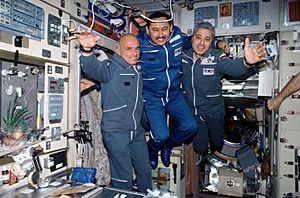
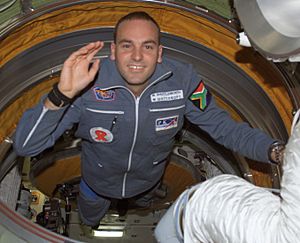
In the late 1990s, a private company in charge of the Mir space station looked for space tourists to help with costs. Dennis Tito, an American businessman, became their first choice. When Mir was taken out of orbit, Tito changed his trip to the International Space Station (ISS) using a Russian Soyuz spacecraft. He visited the ISS for seven days in April–May 2001, paying about $20 million.
After Tito, others followed:
- Mark Shuttleworth from South Africa in April 2002.
- Gregory Olsen in October 2005.
- Anousheh Ansari from Iran/America in September 2006 (the first female space tourist).
- Charles Simonyi, an American businessman, in April 2007. He became the first person to go to space twice as a tourist, flying again in March 2009.
- Richard Garriott from Britain/America in October 2008.
- Guy Laliberté from Canada in September 2009.
These were the last tourists until Japanese nationals Yusaku Maezawa and Yozo Hirano flew on Soyuz MS-20 in December 2021.
After the Space Shuttle retired in 2011, Soyuz rockets were the only way to get to the ISS, so tourism stopped again. But on September 16, 2021, the Inspiration4 mission launched. It was the first time an all-civilian crew flew an orbital space mission, spending almost three days in orbit on a SpaceX Crew Dragon.
Current Orbital Space Projects
- Axiom Space uses Crew Dragon flights from SpaceX to send crews to the International Space Station. They've had several missions, like Mission 1 in April 2022 and Mission 2 in May 2023. NASA hopes these missions will help create a market for private space travel.
- The Boeing Starliner capsule is also being developed. Boeing plans to sell seats to space tourists on these flights, aiming for prices similar to what Russia charges.
- The Polaris Program: Jared Isaacman, who led the Inspiration4 mission, announced a three-mission program called Polaris. The first mission, Polaris Dawn, will send four private astronauts into Earth orbit, aiming for the highest Earth orbit ever by a crewed spacecraft. It also plans for the first private spacewalk! The last Polaris mission is planned to be the first crewed flight of the new Starship rocket.
Beyond Earth Orbit
Some companies are planning trips even further than Earth's orbit, like around the Moon!
Current Beyond Earth Orbit Projects
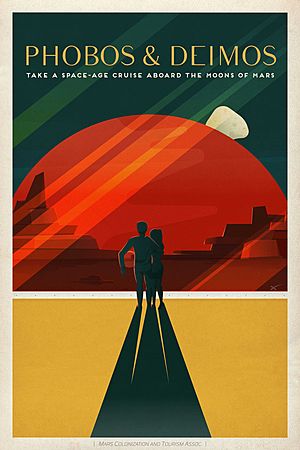
- In February 2017, Elon Musk announced that two people had paid deposits to SpaceX for a trip around the Moon. This trip would use the Starship rocket. In September 2018, Musk revealed the first passenger, Yusaku Maezawa. He plans to take 6–8 artists with him on the journey, hoping to inspire them to create new art. This is called the #dearMoon project.
- Space Adventures has also announced plans for a trip around the Moon, called DSE-Alpha, with a price of $100 million per passenger.
Space Travel Rules
The Outer Space Treaty, signed in 1967, says that the country where a rocket is launched from, or the country of the company launching it, is responsible for any damage that happens.
Even though valuable resources have been found on the Moon, the treaty says that space, including the Moon, cannot be claimed by any country. However, countries can explore the Moon freely, and any resources they collect become their property when brought back.
United States Rules
In December 2005, the US government suggested rules for space tourism. These included checks and training for emergencies, but not strict health requirements.
The US Congress passed the Commercial Space Launch Act of 1984 to encourage private space travel. Under current US law, any company launching paying passengers from American soil needs a license from the Federal Aviation Administration (FAA). This license focuses on public safety. The law also says that passengers fly at their own risk.
In March 2010, New Mexico passed a law called the Spaceflight Informed Consent Act. This law protects companies that offer private space flights from being sued if someone gets hurt or dies due to the normal risks of spaceflight. However, companies are still responsible for serious carelessness or bad behavior.
In December 2021, the FAA announced it would list anyone who travels 50 miles (80 km) above Earth on an FAA-licensed flight on its website. This ended a program where the FAA gave "Commercial Space Astronaut Wings" to people who flew above 50 miles.
List of Space Tourism Trips
This list shows trips where someone paid (or someone paid for them) to go above the Kármán Line (100 km) or the US definition of space (80 km). It also includes future planned trips.
| Flight up (craft) |
Flight down (craft) |
Duration | Mission | Tourist(s) | Destination | Fee paid | Tour company | |
|---|---|---|---|---|---|---|---|---|
| April 28, 2001 (Soyuz TM-32) |
May 6, 2001 (Soyuz TM-31) |
8 days | ISS EP-1 | International Space Station | US$20 million | Space Adventures | ||
| April 25, 2002 (Soyuz TM-34) |
May 5, 2002 (Soyuz TM-33) |
10 days | ISS EP-2 | US$20 million | ||||
| October 1, 2005 (Soyuz TMA-7) |
October 10, 2005 (Soyuz TMA-6) |
10 days | ISS EP-3 | US$20 million | ||||
| September 20, 2006 (Soyuz TMA-9) |
September 29, 2006 (Soyuz TMA-8) |
10 days | ISS EP-4 | US$20 million | ||||
| April 7, 2007 (Soyuz TMA-10) |
April 21, 2007 (Soyuz TMA-9) |
10 days | ISS EP-12 | US$25 million | ||||
| October 12, 2008 (Soyuz TMA-13) |
October 24, 2008 (Soyuz TMA-12) |
13 days | ISS EP-13 | US$30 million | ||||
| March 26, 2009 (Soyuz TMA-14) |
April 8, 2009 (Soyuz TMA-13) |
14 days | ISS EP-14 | US$35 million | ||||
| September 30, 2009 (Soyuz TMA-16) |
October 11, 2009 (Soyuz TMA-14) |
12 days | ISS EP-15 | US$35 million | ||||
| July 20, 2021 (RSS First Step) |
July 20, 2021 (RSS First Step) |
10 minutes | NS-16 |
|
Sub-orbital spaceflight (Kármán line) |
Blue Origin | ||
| September 16, 2021 (Crew Dragon Resilience) |
September 19, 2021 (Crew Dragon Resilience) |
3 days | Inspiration4 |
|
Low Earth Orbit | SpaceX | ||
| October 13, 2021 (RSS First Step) |
October 13, 2021 (RSS First Step) |
10 minutes | NS-18 |
|
Sub-orbital spaceflight (Kármán line) |
Blue Origin | ||
| December 8, 2021 (Soyuz MS-20) |
December 20, 2021 (Soyuz MS-20) |
12 days | ISS EP-20 | International Space Station | Space Adventures | |||
| December 11, 2021 (RSS First Step) |
December 11, 2021 (RSS First Step) |
10 minutes | NS-19 |
|
Sub-orbital spaceflight (Kármán line) |
Blue Origin | ||
| March 31, 2022 (RSS First Step) |
March 31, 2022 (RSS First Step) |
10 minutes | NS-20 |
|
||||
| April 8, 2022 (Crew Dragon Endeavour) |
April 25, 2022 (Crew Dragon Endeavour) |
17 days | Ax-1 | International Space Station | US$55 million each | Axiom Space | ||
| June 4, 2022 (RSS First Step) |
June 4, 2022 (RSS First Step) |
10 minutes | NS-21 |
|
Sub-orbital spaceflight (Kármán line) |
Blue Origin | ||
| August 4, 2022 (RSS First Step) |
August 4, 2022 (RSS First Step) |
10 minutes | NS-22 |
|
||||
| May 21, 2023 (Crew Dragon Freedom) |
May 31, 2023 (Crew Dragon Freedom) |
10 days | Ax-2 | International Space Station | Axiom Space | |||
| August 10, 2023 (VSS Unity) |
August 10, 2023 (VSS Unity) |
15 minutes | Galactic 02 | Sub-orbital spaceflight (~90 km) |
Virgin Galactic | |||
| September 8, 2023 (VSS Unity) |
September 8, 2023 (VSS Unity) |
15 minutes | Galactic 03 | Sub-orbital spaceflight (~90 km) |
||||
| October 6, 2023 (VSS Unity) |
October 6, 2023 (VSS Unity) |
15 minutes | Galactic 04 | Sub-orbital spaceflight (~90 km) |
Why People Want to Go to Space
A 2018 survey found the top reasons people want to buy a space trip:
- To experience something truly unique and special.
- To see the amazing view of Earth from space.
- To learn more about the world.
However, the same study found that only about 43% of Americans were very interested in going to space. NASA astronaut K. Megan McArthur has warned space tourists that spaceflight is uncomfortable and risky, and it takes a lot of courage.
Some studies suggest that most people would want to spend less than two weeks in space. Many would also want to do a spacewalk, even if it cost more!
Some people have criticized space tourism. For example, Günter Verheugen from the European Commission said it's "only for the super-rich," which he disagreed with. Also, Prince William suggested in 2021 that rich people should focus on saving Earth instead of going to space.
Space Tourism and the Environment
A 2010 study worried that more commercial spaceflights could make global warming worse. The study looked at what would happen if 1,000 suborbital rockets launched from one place. It found that this could release a lot of "black carbon" (soot) into the atmosphere. This soot could make temperatures drop in some areas and rise near the poles. It could also affect the ozone layer, which protects us from the sun. Researchers said these results show how sensitive our atmosphere is to many rocket launches.
A 2022 study also looked at air pollution from rockets and space junk. It concluded that if space tourism becomes common, it could have big effects on climate change and the ozone layer. This means we might need new rules for space travel to protect our planet.
Learning About Space Tourism
Several groups have been created to support space tourism, like the Space Tourism Society. There are also magazines, like UniGalactic Space Travel Magazine, that teach about space tourism and exploration.
You can even take classes on space tourism at universities like the Rochester Institute of Technology in New York and Keio University in Japan. Embry-Riddle Aeronautical University in Florida started a worldwide space tourism course in 2017.
Money and Space Tourism
A 2010 report from the Federal Aviation Administration suggested that space tourism could become a billion-dollar business within 20 years. While only eight tourists went to orbit between 2001 and 2009, companies hope these numbers will grow a lot as new rockets become available.
A 2022 report predicts that the global space tourism industry could reach $8.67 billion by 2030, growing very quickly each year!
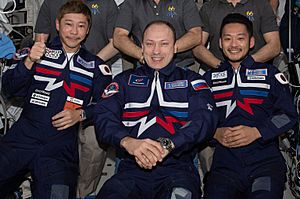
Images for kids
-
Soyuz MS-20 crew on the International Space Station: Yusaku Maezawa (space tourist), Alexander Misurkin (cosmonaut), and Yozo Hirano (space tourist).
-
The first space tourist, Dennis Tito (left) aboard the ISS.
-
Space tourist Mark Shuttleworth.
-
Artist conception of a Mars tourism poster, made by SpaceX.
See also
 In Spanish: Turismo espacial para niños
In Spanish: Turismo espacial para niños
- Commercialization of space
- Effect of spaceflight on the human body
- Private spaceflight
- Space flight participant
- Sub-orbital spaceflight
- Commercial astronaut



